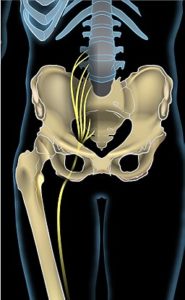Sciatica describes pain caused by irritation to the sciatic nerve. The sciatic nerve originates from the L4-L5 and S1-S3 sacrum joints of the lower spine. It travels through the pelvis and then down behind the hamstrings into the back of the knee joint. The nerve then splits into the peroneal and tibial nerve.

Pain can be mild to severe. With aching, stabbing or shooting sensations around one buttock and/or down the back of the thigh. Certain movements such as bending over or going up stairs or being sat in one position for an extended period of time can cause sciatica.
Moving into a different position or taking weight off the effected limb can reduce the symptoms. Usually the longer you’ve had the problem the longer it can take symptoms to subside. The cause of sciatica is commonly related to hip muscle injury, tightness or weakness. Piriformis syndrome is a common cause. It’s generally simple to treat with sports therapy (specific exercises) and stretching.
Safe and effective ways to manage Sciatica
Hip stretches could help initially by restoring flexibility. Click here to see examples. Start gently with any movements and then build up when you feel less pain. Exercises which strengthening the muscles around your hips lower back and core are normally prescribed. You need to start with ‘basic’ exercises first and build-up slowly. There is a fine line between ‘too little’ and ‘too much’. And the longer you have had the problem the finer the line becomes!
It maybe that ‘self-stretching’ is not enough to resolve the problem. At our clinic we use various treatment techniques to ‘release’ muscle tension and can give specific advice for you to ensure you don’t get the problem again! You can book an appointment online here.
In a very small number of cases structural problems such as herniated discs and spinal fractures can cause the symptoms. This may irritate the sciatic nerve roots as they emerge from the spine. If relief from pain cannot be found when shifting position or you have numbness in thighs or groin then urgent investigation by a doctor is recommended. See information from the NHS about sciatica.

 Enter your name and email and request our free ebook: 7 Habits of Highly Effective Runners
Enter your name and email and request our free ebook: 7 Habits of Highly Effective Runners